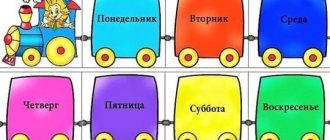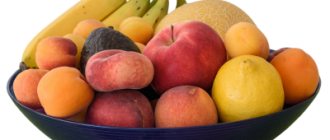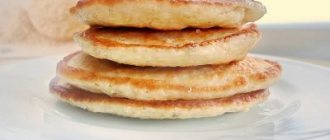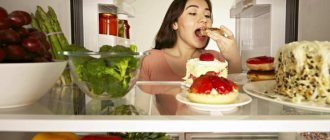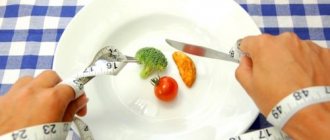Basic principles of the 6 petals diet
The approach to the diet is creative; during preparation, motivation increases. This is a psychological moment that is needed to complete the cycle without disruption.
The “6 petals” diet (the menu for each day will be presented below) has distinctive features:
- designed for a minimum period of 6 days;
- requires a large amount of liquid;
- you need to follow several rules so as not to immediately regain the lost weight;
- based on separate nutrition;
- the list of products alternates in a certain order.
Nutrition consists of a set of mono-diets, when a woman consumes only 1 product every day.
It is strictly forbidden to combine carbohydrate foods with protein foods. The combination of different groups of products leads to incomplete breakdown of the components. They interfere with each other, undigested excess passes into adipose tissue.
Losing weight will become less burdensome if you approach the issue creatively. The diet plan is called “floral”, since the person losing weight depicts a flower with 6 petals in any form. They can be made of white colored paper or cardboard.
Each element is marked with an inscription indicating the order of the day and a signature indicating what type of diet awaits. In the evening the element is torn off. The flower is placed in plain sight to control the outcome and remind oneself of the limitations.
Nutrition is designed for a short period of time, since it limits the body in essential nutrients; the point is daily monotony. If you extend the diet, it can cause health problems. The diet can be repeated no more than 2 times a year. With a slight excess weight, a loss of 4 kg becomes noticeable.
Anyone losing weight should take into account that of the weight that is lost daily, not the entire volume is occupied by fat, only about 150 g. The rest is liquid, intestinal contents, and muscle mass.
Pros and cons of the diet
The “6 petals” diet (the menu for every day can be varied, despite the fact that only one product is allowed) has its positive and negative sides.
The positive points include:
- short period of time before the effect occurs;
- high result, up to 4 kg per course;
- does not require calculation of the energy value of the diet;
- The product of the day can be prepared in different ways;
- no need to starve;
- does not cause addiction to the diet;
- Inexpensive, everyone can choose the right type of product to suit their pocket.
There are also negative aspects to losing weight:
- sugar is completely eliminated, which can be difficult for those with a sweet tooth;
- same type of daily diet;
- the components of the day are low in calories;
- you need to drink plenty of clean water;
- with a quick return to the usual diet, the weight is soon restored;
- time-consuming and difficult to comply with for workers.
In order for weight to move to a dead point, you need to reduce calorie intake and increase fluid volume. This causes hunger as energy expenditure exceeds consumption. 100 g of breast or an apple does not allow you to feel full for 3 hours. During physical activity, subcutaneous fat begins to be consumed to meet needs.
Diet rules
To achieve a positive result, you need to pay attention to the following nutritional rules:
- Only 1 product per day is allowed; it can be supplemented with salt or spices.
- The volume is limited: protein diet up to 500 g, maximum amount of plant food - 1.5 kg. It is allowed to drink broth based on the main product, with the addition of herbs, on days 1 and 3.
- The “6 petals” diet, the menu for which every day involves the introduction of a large volume of liquid, requires drinking at least 2 liters, excluding drinks and soup. Additionally, green and herbal tea is allowed between meals.
Coffee is not recommended because it retains fluid. Lovers of the drink can afford to drink a weak version, without milk, cream and sugar.
On any day other than a fruit day, it is not recommended to drink:
- compote;
- fruit drink;
- fresh
Food should be taken 5-6 times a day, the mass of the daily product is calculated at 500 (on a fish, chicken day) or 1500 g (vegetable day), so it is more convenient to count on 5 meals. The daily volume is divided into equal portions. Cooking method: steamed, boiled or baked.
Menu
For the 6 petals diet, you need to create your own menu for each day. You can prepare complex and unusual dishes to make this time more enjoyable and interesting. Or, on the contrary, there is an opportunity not to bother yourself with cooking, because dietary dishes can be simple and very quickly prepared.
For example, you don’t need to spend a lot of time boiling or baking chicken fillet, or preparing buckwheat porridge in water. In this case, the diet will be an excellent solution for a “busy” week, when there is a lot to do and you don’t want to spend several hours in the kitchen. And the detailed menu provided will make cooking even simpler and faster.
Day 1 – fish
During the “fish petal” you can eat any product from this group, and it can even be fatty fish (herring, salmon). From dietary varieties, choose whatever you want: flounder, hake, cod, pollock, tilapia, etc. You can consume a maximum of 0.5 kg of fish per day.
Between meals, drink fish broths, but not more than 500 ml per day. They will not let you feel hungry throughout the day.
BREAKFAST: 150 g of baked hake (save 50 g for a second snack).
SNACK 1: 50 g lightly salted herring.
LUNCH: 150 g boiled flounder (or other fish).
SNACK 2: 50 g baked hake.
DINNER: 100 g steamed perch.
SECOND DINNER: 200 ml of fish broth (you can use the leftover from cooking the flounder).
Day 2 – vegetable
On vegetable day, you can eat anything, even starchy foods (like potatoes). The only condition is volume. You can eat 1-1.5 kg of vegetables per day. It is best not to limit yourself to one type of fruit. Make your daily menu varied and include different types of vegetables. In addition (to the main volume of liquid) on this day between meals, drink from 200 to 500 ml of vegetable juice (not store-bought).
BREAKFAST: raw vegetable salad (tomato, cucumber, bell pepper).
SNACK 1: Cauliflower and zucchini baked in foil.
LUNCH: tomato soup.
SNACK 2: Broccoli smoothie.
DINNER: boiled potatoes.
SECOND DINNER: carrot pudding.
Day 3 – chicken
It is best to choose chicken fillet, this part of the carcass is the most dietary. If you buy breast or other part of the bird, be sure to remove the skin before cooking.
You can cook meat by steaming, in the oven, on the grill, as well as boiling and stewing. The daily norm is 0.5 kg. During the day, you can drink up to half a liter of chicken broth (low-fat).
BREAKFAST: 100 g stewed fillet with herbs (dill, parsley, cilantro).
SNACK 1: 50 g boiled fillet.
LUNCH: 150 ml chicken broth with chopped fillet (100 g) and herbs.
SNACK 2: 50 g chicken fried without oil.
DINNER: 150 g of meat baked in foil.
SECOND DINNER: 200 ml chicken broth.
Day 4 – cereal
On this day, the basis of the diet is cereals, mainly various cereals. It is best to opt for buckwheat, rice and oatmeal. If desired, you can expand the list of millet, wheat, and barley porridges. It is not forbidden to eat pasta on this day, but only from durum wheat. Additionally, you can drink decoctions of cereals, for example, oatmeal is very useful.
Limitations in quantity: 200-300 g of dry cereal or pasta (when cooked, this volume will be larger). You can cook one type of porridge (the entire permitted amount at once) and divide it into 5-6 meals, or prepare a separate dish for each time. For this occasion, a detailed menu for the day has been prepared.
BREAKFAST: 80 g buckwheat with parsley.
SNACK 1: 30 g oatmeal.
LUNCH: 80 g of brown rice (you can use white) with a spoon of honey. If you don't like sweet porridge, replace honey with 5 grams of soy sauce.
SNACK 2: 30 g of wheat cereal with dill and cilantro.
DINNER: 80 g pasta with herbs.
SECOND DINNER: 200 ml oatmeal broth.
All calculations are taken for dry cereals, and not ready-made cereals! When preparing the first serving, take approximately 80 g of cereal and 220 ml of water.
Day 5 – curd
On this day, as on other protein days, you can eat only 0.5 kg of food (water and tea are not included in this number) and drink 200-300 ml of low-fat (maximum 1%) milk. In addition to cottage cheese, you can consume kefir with a fat content of up to 2.5% and low-fat sour cream.
BREAKFAST: 100 g of cottage cheese and 20 g of low-fat sour cream.
SNACK 1: 100 ml kefir.
LUNCH: 120 g of cottage cheese with a spoon of honey.
SNACK 2: 80 g of curd ice cream.
DINNER: 80 g cottage cheese.
SECOND DINNER: 200 ml of milk.
Day 6 – fruity
You can eat any fruits and berries that you have at your disposal. Volume limit: 1-1.5 kg per day. Additionally, drink up to 0.5 liters of fruit juices (not store-bought), compotes, jelly or fruit drinks.
BREAKFAST: fruit salad (peach, mango, kiwi).
SNACK 1: baked apple.
LUNCH: fruit puree.
SNACK 2: fruit and berry smoothie or just 1 banana.
DINNER: 2 apples and berry jelly.
SECOND DINNER: grapes or grapefruit.
Contraindications to the “6 petals” diet
There are restrictions on the use of this type of weight loss.
“6 petals” cannot be used for:
- pregnancy;
- breastfeeding;
- children and teenagers.
The breakdown of fat can cause intoxication in childhood, since lactic acid is involved in its metabolism. Children's organs are still growing, so a lack of vitamins and minerals can interfere with harmonious development.
In addition, contraindications include:
- avitaminosis;
- 6 months after birth;
- infectious process;
- digestive disorders;
- ARVI or other respiratory diseases;
- diabetes;
- cardiovascular disorders;
- endocrine pathologies.
To establish that there are no health problems, you should consult a doctor before going on a diet.
Contraindications
- chronic liver diseases;
- stomach ulcer;
- kidney diseases;
- diabetes;
- any diseases for which a strict diet is indicated;
- heart disease;
- You cannot follow a diet during pregnancy and breastfeeding.
The flower nutrition system is indicated for weight loss for almost all categories of people, as it does not involve fasting. However, whether the “6 petals” weight loss system is harmful specifically for your body, your attending physician will answer, based on your state of health. If you follow all the recommendations, weight loss occurs quite quickly, so before you start following this diet, be sure to consult your doctor.
Authorized Products
The nutrition description indicates that it should be distributed over the days:
- Fish and seafood;
- plant food;
- lean poultry;
- cereals;
- fermented milk day;
- fruit.
The “6 petals” diet (the menu for every day is given below ) seems boring and monotonous. If you wish, if you use your imagination, you can find many cooking options for each product.
Allowed foods for different days of the diet:
- For 1 day, sea and river fish with any fat content or broth based on them with the addition of herbs and spices are suitable. The category of permitted products includes seafood (shrimp, squid, mussels). The fat contained in fish is easily digestible (polyunsaturated fatty acids), so it will not harm your figure. On this day it is also allowed to diversify the menu with seaweed.
- The second day consists of fresh, boiled, stewed vegetables . Potatoes are allowed in small quantities due to their high starch content. Preference should be given to cabbage, root vegetables, tomatoes, cucumbers and peppers. You can make juice from them and use greens. The total amount of vegetables is 1.5 kg.
- Day 3 – chicken. This product can be replaced with other lean meat: rabbit, veal or turkey. If chicken is used, it is boiled, stewed, baked, or steamed. First you need to remove the skin and visible fat. Daily amount – 500 g of ready-made dish.
- Day 4 – cereals. These are not only cereals, but also seeds, bran, and grain breads. On this day, you can combine different types of grains with each meal. 1 of the options is breakfast, lunch and dinner, cooked cereal, snacks - bread or nuts (no more than 30 g at a time). The total amount of dry products should be 200 g.
- Day 5 – cottage cheese. It can be replaced with fermented milk products, yogurt or kefir, low-fat cheese, tofu. In order not to increase the total calorie content due to this day, you need to take into account the fat content of the diet. Cottage cheese should be no more than 5%, kefir and yogurt - 3%. The mass of the main product should be 500 g. If cottage cheese is replaced with kefir or natural yogurt, then the volume is 1 liter.
- The last day is fruity. On this day, you can use fresh, baked varieties, cook compote without adding sugar. You cannot replace fresh fruits with dried ones, they are much higher in calories. Bananas and grapes should not be used due to their high natural sugar content. Fresh fruits are not a substitute for juice because they contain less fiber in liquid form. The total volume of product per day is 1500 g.
If a person wants to go straight to cycle 2 of the diet, then at this stage you can include new foods, going somewhat beyond the strict primary diet. For example, on chicken day, you can cook lean meat of a different type (veal, turkey) for one of your meals. You can add to seafood those that were not used last time (octopus).
Six petals diet menu (Eating routine)
The diet of each new day of the diet consists of new foods. You will have to alternate different menus for six days. A detailed diet can be compiled based on personal taste preferences. The main thing is that you will have to give up frying dishes during the cooking process, as well as adding spices and salt.
A properly selected diet will be balanced in all respects, which will lead to a decrease in body weight, as well as a decrease in volume.
A six day diet might look like this.
The first day. Fish mono-diet
Fish meat contains a large amount of polysaturated acids. They enrich the body with omega-3s, which are healthy fats. Due to them, fat reserves are destroyed, as well as cholesterol levels in the blood decrease. Therefore, there is a strengthening of the heart muscle, reducing the risk of heart attack, stroke, and atherosclerosis. There is a noticeable improvement in metabolism. Fish protein is easily digested and absorbed by the body, suppressing the feeling of hunger. Its content reaches 25%. Amino acids are easily absorbed by the body in 2-2.5 hours.
Sample fish day menu:
- First breakfast. Boiled fish with the addition of a small amount of spices.
- Lunch. Fish cooked in the oven. You can add greens to improve the taste.
- Dinner. Ukha without adding vegetables.
- Afternoon snack. Steamed fish. You can use some spices.
- Dinner. Stewed fish.
Between main meals you are allowed to drink an unlimited amount of fish broth and green tea.
The main dietary products are pike and cod. Salmon, trout, and pink salmon will speed up metabolism due to their high levels of fatty acids. Therefore, you can safely use them.
Frozen fish is an excellent option for safety reasons. But such meat contains fewer nutrients due to heat treatment. Buy fresh fish only from trusted people.
Second day. Vegetable mono-diet
On a vegetable day, the body receives large quantities of plant fiber, which helps to increase the feeling of satiety and cleanse the body of waste and toxins. Plant carbohydrates are digested slowly, so the body has to use its own energy reserves for this. Thus, fat burning occurs.
Vegetable dishes can be baked or steamed. An excellent option would be to prepare a popular drink today - a smoothie.
Sample vegetable day menu:
- First breakfast. Carrot and cabbage salad.
- Lunch. The vinaigrette.
- Dinner. Stewed vegetable stew with a little salt.
- Afternoon snack. Whole steamed vegetables.
- Dinner. Ratatouille with a little salt and spices.
Between main meals, you are allowed to drink unlimited quantities of fresh vegetable juice and unsweetened tea.
Day three. Chicken mono diet
The composition of lean chicken meat contains a large amount of amino acids and nutrients. Chicken protein will not turn into fat deposits, so the body has to spend its own reserves to restore anergy.
Sample chicken day menu:
- First breakfast. Chicken fillet, boiled without skin. You can add a little salt.
- Lunch. Chicken fillet can be baked in a baking oven with a small amount of spices.
- Dinner. Chicken soup, to which you can add a little seasoning.
- Afternoon snack. Chicken fillet cooked on the grill.
- Dinner. Chicken meat, steamed with a little salt.
To drink chicken broth between meals, you need to strain it. You are also allowed to drink unsweetened tea unlimitedly.
Day four. Cereal mono-diet
The fourth day of the diet involves eating cereals that have not been husked. You can safely eat whole grain bread. The best way to prepare porridge is steaming, thanks to which the cereal will not lose nutrients and is better absorbed by the human body.
Sample cereal day menu:
- First breakfast. Steam sprouted wheat grains with water and prepare porridge.
- Lunch. Green buckwheat, cooked as porridge with a little salt.
- Dinner. Brown rice boiled in water.
- Afternoon snack. Oatmeal porridge, pre-soaked overnight.
- Dinner. Barley porridge, slightly salted.
On a cereal day, you can drink a little natural kvass and unlimited quantities of unsweetened tea.
Day five. Curd mono-diet
Cottage cheese will help replenish calcium reserves in the human body. The amino acids included in its composition contribute to the restoration and renewal of cellular structures. It is better to give preference to natural cottage cheese with a low fat content.
Sample menu for curd day:
- First breakfast: low-fat cottage cheese with a small addition of natural yogurt.
- Second breakfast: grainy cottage cheese.
- Lunch: a combination of low-fat cottage cheese and milk.
- Afternoon snack: casserole;
- Dinner: low-fat cottage cheese without additives.
Between main meals, milk, kefir and unsweetened teas are allowed.
Day six. Fruit mono-diet
Finally, the body will be replenished with energy due to the intake of complex carbohydrates, as well as polysaccharides from fruits. In addition, they contain pectin, vitamins, enzymes, and amino acids. In addition to them, a large amount of organic substances and antioxidants are supplied. Fruits are a storehouse of nutrients that the body needs when following a diet. Due to their taste, they are much more pleasant to eat than vegetables. But, given their possible calorie content, you will have to carefully select ingredients for nutrition.
Sample fruit day menu:
- First breakfast: a combination of apples of different varieties;
- Second breakfast: large banana.
- Lunch: a variety of citrus fruits.
- Afternoon snack: pomelo.
- Dinner: a combination of kiwi and pineapple.
You can treat yourself to fresh fruit and tea.
How to create a weekly menu for every day
Since you can eat 1 or related products throughout the day, you can experiment with cooking methods. For example, eat stewed fish in the morning, broth with herbs for lunch, and bake it in the evening.
Sample menu for every day for the 6 petals diet
Thanks to this, thoughts about deviating from the rules and breaking them will come less and less often.
Magic flower on the refrigerator
Get creative with your diet.
Feel free to use your imagination, come up with colors and attractive names for the petals. The sonorously named day will fly by faster, healthy culinary ideas will appear. Useful does not mean boring.
First day - FISH - BLUE, SEA Second day - VEGETABLES - RED, VITAMIN Third - CHICKEN - PINK, LIGHT MEAT Fourth - CEREALS - YELLOW, GOLDEN TIME Fifth - COOK COOK, MILK - WHITE, CALCIUM plus. Sixth – FRUIT – ORANGE, TROPICAL
It is suggested that such a flower be fixed in a visible place so as not to disturb the order of the days. Add a list of vitamins and microelements that you will enrich your diet with daily. This stimulates action, makes your mood brighter, and your diet easier. The main thing is a positive attitude.
The menu is based on the following scheme: breakfast, second breakfast, lunch, afternoon snack, dinner. Call second breakfast and afternoon snacks “snacks” and snacking is legal! *Below is a sample menu for each day. Plan your meals based on your age, eating habits and general condition.
Menu for every day of the week
The menu for every day in accordance with the “6 petals” diet allows you to plan in advance in what form to prepare the products, how to navigate, so as not to spontaneously think about what to cook.
This video will help you create a menu for every day for your diet:
Monday
Meals by hour:
- 800 hake stew, green tea;
- 1100: river fillet, boiled, with herbs;
- 1400 – fish broth with parsley;
- 1700 – boiled pollock;
- 2000 – salmon fillet in a steamer.
The total mass of products is 500 g, divided into equal portions.
Tuesday
The total amount of food per day is 1500g.
Meals by hour:
- 800 – vegetable salad with black pepper and oregano;
- 1100 – cauliflower and broccoli stew;
- 1400 stewed cabbage with tomatoes;
- 1700 smoothies (tomato, pepper, cucumber, parsley);
- 2000 raw carrots, chopped.
Wednesday
The total weight of food during the day is 0.5 kg.
Meals by hour:
- 800 – boiled poultry fillet;
- 1100 – baked white meat with Italian herbs;
- 1400—chicken broth with herbs;
- 1700 – grilled breast;
- 2000—steamed chicken meatballs
Thursday
The volume of the main ingredient is 200 g in the dry version.
Meals by hour:
- 800 – oatmeal, green tea;
- 1100 – almonds 30 g;
- 1400—rice with milk;
- 1700 – grain breads 30 g;
- 2000 – buckwheat porridge on water with herbs.
Friday
A serving of cottage cheese is 100 g, not counting additional components.
Meals by hour:
- 800 – cottage cheese with the addition of natural yoghurt (50 g);
- 1100 – cottage cheese 5%;
- 1400—1% cottage cheese with added milk (50 ml);
- 1700 – soft cottage cheese;
- 2000 – kefir 200 ml.
Saturday
- 800 – baked apple, herbal tea;
- 1100 – smoothie from apple, kiwi, orange;
- 1400 – fruit salad of pear, mango, banana;
- 1700 – small bunch of grapes;
- 2000 – 2 apples, herbal tea.
Sunday
Domestic nutritionists slightly modified the original idea, adding 1 more day to the main amount. In the absence of physical activity or its limitation , it is recommended to do a fasting day consisting of 2.5 liters of mineral, clean drinking water.
Drinking daily can consist of green or herbal tea; at night you can add 250 ml of kefir 1.0%.
Sample menu 6 petals: table
For your convenience, we have compiled a menu for each day of the “6 petals” diet:
| Breakfast | Lunch | Dinner | Afternoon snack | Dinner | |
| Monday. Fish day. | Steamed fish | Baked in its own juice without spices | Fish soup without vegetables | Boiled fish | Steamed fish |
| Tuesday. Vegetable day. | Cucumber and tomato salad | Boiled potatoes | Vegetable soup | Carrot and green salad | Vegetable stew |
| Wednesday. Chicken day. | Steamed chicken fillet | Chicken cutlets | Chicken broth with a pinch of salt | Boiled chicken fillet | Chicken baked in foil |
| Thursday. Cereal day. | Oatmeal | Buckwheat | Boiled rice | Wheat porridge | Buckwheat |
| Friday. Protein day. | Grain curd | Low-fat yogurt | Tofu | Boiled chicken proteins | Grain curd |
| Saturday. Fruit day. | Apple and pear | Dried apricots and prunes | Watermelon | Grapefruit | Pineapple and apple |
| Sunday. Quitting the diet. | Oatmeal | Apple or grapefruit | Chicken soup and steamed fish | Low-fat yogurt | Stewed vegetables, dried apricots, prunes |
This menu is a recommendation; if necessary, you can make your own adjustments to it, taking into account the available products and capabilities.
Quitting the diet
To ensure results, you need to correctly complete the course of dietary nutrition. Habitual foods should be reintroduced gradually, over several weeks. Every day you need to add 1-2 new products to the menu. Next, you need to adhere to proper nutrition, minimizing foods rich in carbohydrates and saturated fats.
By reducing the volume of the stomach, the portion size remains small. If you diversify your diet and do not abuse fatty foods, you will be able to maintain the results for a long time. When returning to a normal diet, you must adhere to the calorie requirements for meals: for women 1800 kcal (with physical activity 2000), for men - 2200 (2400).
How much can you lose in a week: results, before and after photos
Taking into account a short course of weight loss, it will not be possible to achieve significant results, but even after getting rid of 3.5-4.5 kg, the clothing size decreases by 1, which is 2-4 cm in volume. Externally, the changes are noticeable, as evidenced by numerous photo reports.
You can enhance the results of losing weight not only through strict adherence to all nutrition and drinking requirements, but also through physical activity. They help remove excess volume, pump up the stomach, thighs, and buttocks.
Any diet requires motivation, willingness to accept dietary restrictions, and fortitude. She has her supporters and opponents, including among nutritionists. The maximum result that a woman can get in 7 days, along with drinking water, is 5 kg.
Advice from nutritionists and reviews from doctors about diet
Nutritionists are skeptical about the information provided about this nutrition. It is known that a Swedish nutritionist developed the method, but it is not possible to verify this. Even 10 years ago, the separate food system was actively promoted, information about the effectiveness of separating different food groups was considered more viable than other existing options.
Every day a person needs a balanced diet, which includes:
- proteins;
- fats;
- carbohydrates;
- substances of plant and animal origin.
This is a source of energy, activity, and brain performance. A mono-diet “robs” the body, depriving it of essential substances. The result of this may be loss of strength, lethargy, and symptoms of vitamin deficiency.
Nutritionists are careful when using big words, so they recommend not to get carried away with this and similar types of nutrition. Feelings of hunger should not accompany a diet. Due to the limited amount of food and only one product, not every person is able to withstand such a regime.
Often one of the first arguments in favor of a mono-diet is the opinion that the liver stores enzymes for the breakdown of proteins, fats and carbohydrates. Having become accustomed to a variety of foods, having received a morning dose of food, she waits for another product, digesting the eaten product “in vain.” To cover energy needs, the body begins to use previously stored fat reserves.
Doctors are skeptical about this theory. It is known that the liver is a filter that cleanses the blood of:
- toxins;
- poisons;
- bacteria;
- viruses;
- allergens.
This is a depot of blood and glycogen, a complex carbohydrate, but it does not contain enzymes or other substances. The mechanism of weight loss is more likely due to the fact that, due to a sharp decrease in the caloric content of food that does not meet needs, the available reserves are used up.
A STRONG argument that doctors give against this system is that rapid weight loss is HARMFUL to the body: Over 6 months, weight loss should BE no more than 10%.
Here, 5-7% of body weight is lost in 6 days. This negatively affects the state of the muscular system. The fat that the system is designed to fight is the most reluctant to go away. For a course there are about 900 g, the remaining 4000 is for everything else. Upon completion of the system, the body, due to stress, strives to put as much as possible “in reserve,” which results in additional volumes at the waist.
It is more important for modern society to teach how to eat a varied, healthy diet, how to distribute food throughout the day, and observe the frequency of meals. The “6 petals ” , with a well-thought-out menu for every day, is an emergency option for weight loss from a “dead point”, a plateau. Despite all the negative opinions of doctors, the results prove that it has a right to exist.
Article design: Svetlana Ovsyanikova
Prohibited Products
The “6 Petals” diet imposes clear restrictions on the menu. Which foods are completely prohibited?
- Any baked goods (with the exception of a few slices of whole grain bread on a cereal day).
- All confectionery and prepared sweets, chocolate and any products containing sugar.
- Oil of any origin.
- Smoked and canned products, store-bought semi-finished products.
- Coffee, sparkling water with or without sugar, compote, shelf-stable juice (on a fruit day, you can use some freshly squeezed juice).
- Any products that are not included in the daily menu.
